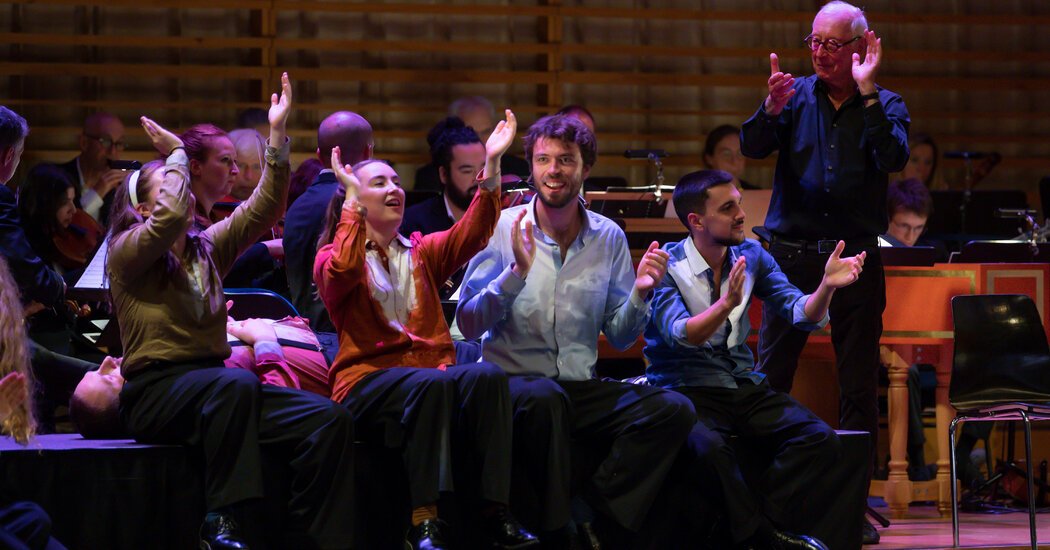[ad_1]
A dancer spins on his back gyroscopically, his legs spiraling in the air. He bounces off his shoulders and stands on his head. The moves come from breaking and hip-hop, but the music is Baroque opera, and the words the moves illustrate are classically allegorical.
Henry Purcell’s semi-opera “The Fairy Queen” (1692) is the kind of work that the esteemed early-music ensemble Les Arts Florissants is known for keeping alive in performance. The production of “The Fairy Queen” that the group is bringing to Lincoln Center on Thursday is a little different, though. It is staged by the French Algerian hip-hop choreographer Mourad Merzouki and features dancers from his troupe, Compagnie Käfig.
And the singers aren’t members of Les Arts Florissants. They’re graduates of Le Jardin des Voix, an intensive training program for young singers that Les Arts’ founder, William Christie, and his co-artistic director, Paul Agnew, have been running for 20 years. From an international pool of more than 200 applicants, just six to eight singers are chosen for the program every two years. In two and a half weeks, they rehearse a production, which then tours the world with Les Arts Florissants musicians.
“We tell the kids that we’re not going to make excuses for them,” Agnew, the production’s musical director, said on a recent video call from France. “They have to be at the level of Les Arts Florissants.”
“We throw them in the deep end of the swimming pool,” Christie said. “And either they sink or swim.”
This time, the swimming has some added difficulty: Merzouki asks the singers to dance.
“The Fairy Queen,” tangentially related to Shakespeare’s “A Midsummer Night’s Dream” and sometimes performed in combination with the play, is a series of court masques. Its songs and arias are sung by allegorical figures like Night, Sleep and the four seasons. Christie can list productions of it that he’s been involved with going back more than half a century, but this one, he said, is “unique.”
“In the opera world, the chorus generally has their feet nailed to the floor,” Christie said. “But Mourad has been able, in an extraordinarily efficient way, to turn dancers into singers and singers into dancers. I’ve never seen it happen anywhere else.”
“There was a will from the start that it would not be singing or dancing, but one show all together,” Merzouki said in French, speaking through an interpreter.
In Merzouki’s staging, the singers don’t do head spins, but they do continually move together with a group of dancers who are dressed indistinguishably from them. The full ensemble of singers and dancers acts out much of the text: playing blindman’s buff, tossing and turning in slumber, swirling like a leaf storm.
Here and there, the dancers — who also include a Juilliard student and a recent graduate — expand into more elaborate and technically demanding choreography, applying Compagnie Käfig’s bouncy footwork, articulated isolations and supple hip-hop acrobatics to Baroque rhythms.
“Purcell proved to have many points in common with street dance,” Merzouki said.
This production isn’t an update, the collaborators stressed. “We’re not saying let’s make Purcell sound like hip-hop,” Agnew said. “We want the singers to sing with the right ornaments and phrasing, exactly as Purcell might have heard it. But everything that Purcell produced lends itself absolutely to the same rhythmic energy and excitement that Mourad produces in dance.”
Another commonality: Both singers and dancers, though drawing from different traditions, have the freedom to find new surprises. “There’s a lot of improvisation in Baroque music,” Christie said. “Every night something different is happening.”
“It’s never the same show,” Agnew said. “Trying to do it the same as yesterday is the biggest mistake you can make.”
Although this is the first opera that Merzouki has staged, his productions with Compagnie Käfig have long experimented with mixing hip-hop and other disciplines. This collaboration, he said, shows how hip-hop is a mature enough art form to fit with opera: “It sends a message that it is possible to break through boundaries, that this improbable meeting is not only possible but successful.”
Christie cited his own long experience resisting snobbery. “I get people who say to me, ‘How can an American conduct French 17th-century music?’ Or ‘You can’t possibly bring the 17th century into the 21st century,’” he said. “Those barriers shouldn’t exist. Mourad’s world and ours have something to say to each other.”
And what is that connection? “Spontaneity,” he said. “I’ve always said that Arts Florissants should give the audience the impression that this music was written perhaps the day before yesterday. That’s why I think Mourad’s world and our world are so close.”
Agnew agreed: “I always have to remind myself that composers like Purcell worked in modern music. And so when we do this piece, it shouldn’t have any wrinkles on it. It should be brand-spanking new.”
[ad_2]
